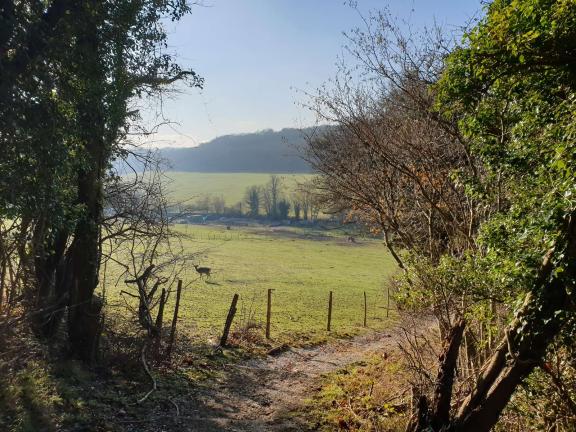This multi-terrain/gravel route heads back inside of the M25 to explore the lovely quiet country roads and seeks adventure down delightful tree-lined bridleways that will no doubt surprise you as to what treasures exist so close to the city of London. You will discover lovely countryside, country pubs and quaint villages which have been home to the likes of Charles Darwin.

Otford Solar System
Starting from the car park in the centre of Otford, you turn left by the village hall and already it’s worth stopping to see the mosaic that runs along the external wall here, telling the story of the village. You are soon back off, heading north along a rough tarmac bridleway track that starts between the tempting Turkish restaurant one side and Sally’s Cake Emporium on the other.
Very soon the village is behind you and you’re out into the countryside, riding alongside the playing fields to the left and farm stables to the right. Opposite the stables is access to the back of the park, where the Otford Solar System monument is situated. This is one of the largest scale models in the world, and helps to show how vast space is with steel structures located in the park using a scale of 1:4,595,700,000 (i.e. 1mm = 4,595.7km)! Back on the route, the trail narrows to become a nice dirt singletrack through a tunnel of trees, and golf course, leading you further up the Darent valley and crossing the river by an old mill. This valley was once a thriving industrial area, with mills powered by the River Darent to produce products such as flour and paper from mills beside the river. Only light industrial businesses remain in the valley today though, with most of the properties having now been converted into homes, but some external features and signs still remain preserved so keep your eyes open.
This area, or the village of Shoreham just to the north of the route here, was home to Shaun Palmer the British landscape painter and key figure in Romanticism in Britain, although little appreciated in his lifetime (1805-1881). He produced visionary pastoral paintings and is now hailed as a precursor of Modernism in the 20th Century and is indelibly linked to the village of Shoreham – his ‘Valley of Vision’ where he lived in a run-down cottage, ‘Rat Abbey’, between 1826 and 1835. He created many of his most celebrated paintings, depicting the area as a mysterious paradise, and you can see some of his prints, while enjoying a pint at the Samuel Palmer pub here.
Wildflowers and hedgerows
After crossing the river (through the ford or over a footbridge) there is a lovely little track along a tributary sprinkled with golden leaves in autumn or with dappled light that pierces the lush green leaves in the spring and summer, lighting up the wild flowers and sparkling on the stream. You now start to climb up out of the valley, offering good views down the valley, across the farmland. An old tarmac track drops you beneath the motorway and then climbs steeply up the other side to a road crossing that may require a bit of patience and care. You are soon back onto quiet country lanes, with wildflowers along the hedgerows and views across the idyllic countryside once more. A nice family run free house pub, The Rose & Crown, in Halstead has a good beer garden with a large covered area if the weather isn’t great, beyond which the route continues to enjoy these quiet, narrow, winding country lanes, until it descends to Knockholt. Keep on Broke Farm Drive rather than the A21 road, which runs parallel, and you’re soon away from the cars once again, climbing off-road into the silence of the countryside. More country lanes guide you through the quiet surroundings where it’s so hard the believe you are just minutes from London and riding within the M25 motorway, as you dive back off-road into moor wonderful woodland bridleway.
Note: For a shortcut to the route, missing out High Elms and Downe village, stay on the road (New Years Lane) past Knockholt farm and just past the interesting cattery building go right into the woods on a bridleway, keeping right at the road, to climb and re-join the main route at The Blacksmith’s Arms pub in Cudham.
High Elms Country Park
The pretty woodland trail leads you down the hillside before wiggling between the fields on changing terrain, ending with a final and fun descent to finish by the A21 road. A path set back from the road guides you to a roundabout where you join a small road which becomes one-way, enabling you to enjoy the swoop of the road as you go. High Elms Country Park is here, and although you cannot ride through the park on bicycles (other than the bridleway which crosses it), it does have a café you can visit and makes a nice place for a picnic. This was once the home to the (wealthy) Lubbocks family who came from Norfolk, purchasing High Elms in 1808. They lived here for some 130 years before kindly ensuring it remained a county estate on its sale in 1938, for all to enjoy.
Charles Darwin
A gradual climb up the hillside delivers you to the quaint village of Downe, where Charles Darwin once lived. A pretty church and a couple of nice pubs, with bench seating around a lone tree in the centre of the village provide another chance to rest and enjoy the setting. You can also however, pedal down the road a short way to Down House, the home of Charles Darwin, which is now owned by English Heritage, who enable you to walk in the vey rooms and gardens where Charles Darwin lived and work. There is also a nice café in the former Darwin’s kitchen too to provide further refreshments. Returning to the route, which now descends from the village for a fun freewheel, before being immediately repaid with a short but steep climb, to the village of Cudham and back down another fun descent. You’ll be pleased to note the ‘unsuitable for HGV’s’ sign at the top, but always be prepared as you zip back down this lovely road, where a roadside barrier beside the edge makes it feel quite dramatic as you zip down the road.
Down House, the family home of Charles Darwin, in the village of Downe. This unique place played a significant part in the history of science and evolution and preserved today as a site of outstanding international significance. Walk in his very same steps and enjoy an exhibition about his life and work (narrated by Sir David Attenborough), and his gardens that acted as his ‘living laboratory’. Watch recreated experiments and discover how his observations helped him develop his ground-breaking theories and explore how it felt to live and work in the Victorian times.
Bikes and beers
A private, potholed road now leads you down a nice tree-lined avenue into quieter, more sedate surroundings, passing large-gated entrances, whose driveways disappear out of sight, no doubt to some grand homes making the most of this tranquil setting and views off the banks of the North Downs. You may only catch glances of the views yourself along this rough track, but you can enjoy descending it all the way down to the bottom of the hillside, which finishes at the wonderful Velo Barn café. This cycle specialist café not only offers riders superb bike racks, great coffee and delicious snacks, but also a small bike shop and its own mechanic too. Take note though, although the café is open from 9-5pm on weekdays, it closes at 1pm on weekends. Should it be closed when you are passing, fear not: despite feeling like you’re in the middle of nowhere, just a little further on, off the route over the M25 is another superb refreshment stop of offer. Westerham Craft Brewery café and taproom offers beers and wonderful street food and there is also a deli and the superb, and more formal, Squerryes winery and restaurant too.
Pilgrim’s Way
Hopefully now refreshed, you’re now on the homeward leg of the route, following a road running along the side of the hill, along a historical Pilgrim’s Way. You follow this hedge-lined road which cuts between the rolling fields, offering lovely views in all directions, until your way becomes blocked by Chevening Park ahead. This is your cue to turn south, dropping off the lower banks of the hill and crossing to the other side of the valley, crossing the M25 as you go. After passing the grounds of Radnor House Sevenoaks independent school, which peeps out at you from between the tall conifer trees that flank it, you start to climb the far side, but soon turn to ride across this hillside also. Bridleways and farm tracks lead you along the hillside, past Dryhill where an old watermill can be seen, still clinging to what is now a home, before heading back into the fields once more, through the Montreal Estate, back to the Darent River. On a warm day, being so close to the finish, you may want to extend your day by heading to Chipstead Lake just here, with an opportunity for open water swimming (by Triswim). All that’s left afterwards is a lovely roll back along Rye Lane, through the quiet countryside and farmland. As you roll back into Otford it’s hard to believe you’ve been riding mostly inside of the M25 motorway, just 30 minutes from the capital city.
Disclaimer
All routes are followed at a rider’s own risk. These routes are intended to be general guides: please observe all road signs, waymarks and other specific on-route instructions. Neither Cycling UK nor individual route authors can be held responsible for any errors or consequences that arise from using this route information. Essentially: go out, be sensible, have fun. If you believe there is an important issue with this route then please report it using the button below.
Supported by

